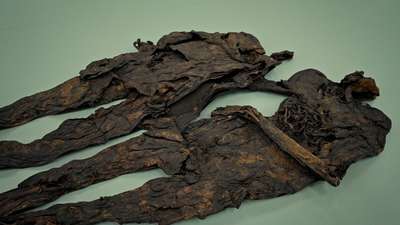Tutankhamonin aarteet: piilotetut salaisuudet
ti 14.03.2023 18.00 - 19.00 60 min
A beautifully crafted ceremonial dagger made of iron found wrapped inside his mummified corpse has perplexed Egyptologists since it was first discovered. At the time of Tut's reign, the use of iron was not only rare - it was a metal the Ancient Egyptians had almost no expertise in. Now using X-ray analysis scientists have confirmed the iron came from a meteorite- suggesting Tutankhamun believed he had the blessings of the gods Now a brand new revelation suggests he also saw himself as a player on the world stage. Howard Carter found 1500 gold fragments underneath the chariots stacked inside the tomb but couldn't reconstruct the objects the fragments came from. Now, after years of painstaking conservation, they can be revealed as golden decorations for the chariots and the horses that would have pulled them. These breath-taking designs, not seen since the tomb doors were shut 3,300 years ago, portray Tutankhamun as an international leader, a king at the centre of the world.. Another treasure, hidden from view for decades, now reveals he was prepared to go to war to establish his superiority. The latest imaging techniques reveal that Tutankhamun's personal leather tunic is actually cutting edge battle armour- light, flexible but able to withstand the impact of an arrow. It was clothing designed to be used in war. As the evidence from the unseen golden artwork, the celestial dagger and the weapons of war come together we uncover the story of a boy who dragged a failing Egypt back from the brink and, in doing so, built an international reputation as a leader in less than a decade- a young King and leader who was powerful enough to re-establish a failing Egypt at the centre of the ancient world.
Tutankhamonin aarteet: piilotetut salaisuudetU
pe 16.09.2022 16.00 - 17.00 60 min
Of the 5,398 treasures from Tutankhamun's tomb at the Grand Egyptian Museum in Cairo, the ones that paint a picture of Tutankhamun's family are the most unsettling. Particularly intriguing are two tiny mummified babies. Now in the labs of the museum, they give a chilling insight into the bizarre practices that kept the Pharaoh's dynasty in power and ultimately lead to its downfall. DNA analysis reveals the foetuses are Tutankhamun's stillborn children - the offspring of an incestuous relationship between Tutankhamun and his sister. Similarly, DNA evidence suggests Tutankhamun was also the result of incest. Artefacts hidden for years in museum basements hint that he suffered genetic abnormalities and lived in constant pain. Golden slippers, rescued from almost certain disintegration by the Museum's conservators, reveal additional straps to hold the pharaoh's foot inside the shoe. Whilst the wear and tear on beautifully crafted walking sticks suggest he needed support for even simple tasks like walking. Could Tutankhamun's disability and the death of his unborn children be related? A genetics expert thinks so and shows how the royal family's incest magnified genetic weaknesses, which can cause conditions such as Tutankhamun's clubfoot and miscarriage. But Tutankhamun and his royal family weren't just afflicted by inbreeding - he also inherited a broken and failing Egypt from his father Akhenaten's disastrous attempt to change the religion of the country and build a new capital. A generation of children and young people died building Akhenaten's city in the desert and Egypt lost land to its enemies. It was a poisonous legacy that Tutankhamun tried to escape but failed. Tutankhamun died early at the age of 19, possibly at the head of his troops far from home. The evidence suggests his disability may have contributed to a fatal chariot accident. Thanks to the devastating deeds of his father, Tutankhamun was buried in a small tomb and quickly erased from official Egyptian
Tutankhamonin aarteet: piilotetut salaisuudetU
to 15.09.2022 16.00 - 17.00 60 min
In 1922 Howard Carter made a stunning discovery - King Tutankhamun's tomb. Crammed inside were over 5,000 priceless artefacts of every type - from gold slippers to finely tooled daggers, the remains of chariots and the boy king's show-stopping solid gold death mask. For the first time in 90 years these incredible treasures are being brought back together as the starring attraction in Cairo's brand-new #750 million Grand Egyptian Museum. Now, advances in modern technology are uncovering new secrets about a boy king who died before his twentieth birthday and the ancient land he ruled. King Tut's incredible death mask - 24lbs of pure gold - has always been the subject of debate with many scholars believing its damaged nameplate, known as a cartouche, and different colours of gold meant it was never made specifically for him. It was more likely made for his female ancestor, Nefertiti. And, until now, the evidence seems to back that theory up. New analysis of some of his many burial goods, including 'Shabtis'- miniature effigies that were meant to act as servants in the afterlife- suggest up to a quarter of all the treasures in the tomb were made for someone else. Closer analysis at the Grand Egyptian Museum of the funeral beds also paint a picture of a rushed burial where the funeral planners were caught by surprise at Tutankhamun's sudden, unexpected death and there wasn't enough time to provide the regal burial a pharaoh would expect. So could the death mask- the world's most famous ancient object- also be a reused artefact from another tomb? Now the mask has been subjected to the most forensically intense investigation ever to try and answer that question once and for all. The result flies in the face of much of the other evidence from the tomb. Tutankhamun may have been buried with many second hand goods but the mask wasn't one of them - the pharaoh's death mask was made especially for him and in only 70 days.
Tutankhamonin aarteet: piilotetut salaisuudetU
ke 14.09.2022 15.55 - 16.55 60 min
A beautifully crafted ceremonial dagger made of iron found wrapped inside his mummified corpse has perplexed Egyptologists since it was first discovered. At the time of Tut's reign, the use of iron was not only rare - it was a metal the Ancient Egyptians had almost no expertise in. Now using X-ray analysis scientists have confirmed the iron came from a meteorite- suggesting Tutankhamun believed he had the blessings of the gods Now a brand new revelation suggests he also saw himself as a player on the world stage. Howard Carter found 1500 gold fragments underneath the chariots stacked inside the tomb but couldn't reconstruct the objects the fragments came from. Now, after years of painstaking conservation, they can be revealed as golden decorations for the chariots and the horses that would have pulled them. These breath-taking designs, not seen since the tomb doors were shut 3,300 years ago, portray Tutankhamun as an international leader, a king at the centre of the world.. Another treasure, hidden from view for decades, now reveals he was prepared to go to war to establish his superiority. The latest imaging techniques reveal that Tutankhamun's personal leather tunic is actually cutting edge battle armour- light, flexible but able to withstand the impact of an arrow. It was clothing designed to be used in war. As the evidence from the unseen golden artwork, the celestial dagger and the weapons of war come together we uncover the story of a boy who dragged a failing Egypt back from the brink and, in doing so, built an international reputation as a leader in less than a decade- a young King and leader who was powerful enough to re-establish a failing Egypt at the centre of the ancient world.
Tutankhamonin aarteet: piilotetut salaisuudet
ke 14.09.2022 08.10 - 08.55 45 min
Of the 5,398 treasures from Tutankhamun's tomb at the Grand Egyptian Museum in Cairo, the ones that paint a picture of Tutankhamun's family are the most unsettling. Particularly intriguing are two tiny mummified babies. Now in the labs of the museum, they give a chilling insight into the bizarre practices that kept the Pharaoh's dynasty in power and ultimately lead to its downfall. DNA analysis reveals the foetuses are Tutankhamun's stillborn children - the offspring of an incestuous relationship between Tutankhamun and his sister. Similarly, DNA evidence suggests Tutankhamun was also the result of incest. Artefacts hidden for years in museum basements hint that he suffered genetic abnormalities and lived in constant pain. Golden slippers, rescued from almost certain disintegration by the Museum's conservators, reveal additional straps to hold the pharaoh's foot inside the shoe. Whilst the wear and tear on beautifully crafted walking sticks suggest he needed support for even simple tasks like walking. Could Tutankhamun's disability and the death of his unborn children be related? A genetics expert thinks so and shows how the royal family's incest magnified genetic weaknesses, which can cause conditions such as Tutankhamun's clubfoot and miscarriage. But Tutankhamun and his royal family weren't just afflicted by inbreeding - he also inherited a broken and failing Egypt from his father Akhenaten's disastrous attempt to change the religion of the country and build a new capital. A generation of children and young people died building Akhenaten's city in the desert and Egypt lost land to its enemies. It was a poisonous legacy that Tutankhamun tried to escape but failed. Tutankhamun died early at the age of 19, possibly at the head of his troops far from home. The evidence suggests his disability may have contributed to a fatal chariot accident. Thanks to the devastating deeds of his father, Tutankhamun was buried in a small tomb and quickly erased from official Egyptian
Tutankhamonin aarteet: piilotetut salaisuudet
ti 13.09.2022 08.10 - 08.55 45 min
In 1922 Howard Carter made a stunning discovery - King Tutankhamun's tomb. Crammed inside were over 5,000 priceless artefacts of every type - from gold slippers to finely tooled daggers, the remains of chariots and the boy king's show-stopping solid gold death mask. For the first time in 90 years these incredible treasures are being brought back together as the starring attraction in Cairo's brand-new #750 million Grand Egyptian Museum. Now, advances in modern technology are uncovering new secrets about a boy king who died before his twentieth birthday and the ancient land he ruled. King Tut's incredible death mask - 24lbs of pure gold - has always been the subject of debate with many scholars believing its damaged nameplate, known as a cartouche, and different colours of gold meant it was never made specifically for him. It was more likely made for his female ancestor, Nefertiti. And, until now, the evidence seems to back that theory up. New analysis of some of his many burial goods, including 'Shabtis'- miniature effigies that were meant to act as servants in the afterlife- suggest up to a quarter of all the treasures in the tomb were made for someone else. Closer analysis at the Grand Egyptian Museum of the funeral beds also paint a picture of a rushed burial where the funeral planners were caught by surprise at Tutankhamun's sudden, unexpected death and there wasn't enough time to provide the regal burial a pharaoh would expect. So could the death mask- the world's most famous ancient object- also be a reused artefact from another tomb? Now the mask has been subjected to the most forensically intense investigation ever to try and answer that question once and for all. The result flies in the face of much of the other evidence from the tomb. Tutankhamun may have been buried with many second hand goods but the mask wasn't one of them - the pharaoh's death mask was made especially for him and in only 70 days.
Tutankhamonin aarteet: piilotetut salaisuudet
ma 12.09.2022 08.30 - 09.15 45 min
A beautifully crafted ceremonial dagger made of iron found wrapped inside his mummified corpse has perplexed Egyptologists since it was first discovered. At the time of Tut's reign, the use of iron was not only rare - it was a metal the Ancient Egyptians had almost no expertise in. Now using X-ray analysis scientists have confirmed the iron came from a meteorite- suggesting Tutankhamun believed he had the blessings of the gods Now a brand new revelation suggests he also saw himself as a player on the world stage. Howard Carter found 1500 gold fragments underneath the chariots stacked inside the tomb but couldn't reconstruct the objects the fragments came from. Now, after years of painstaking conservation, they can be revealed as golden decorations for the chariots and the horses that would have pulled them. These breath-taking designs, not seen since the tomb doors were shut 3,300 years ago, portray Tutankhamun as an international leader, a king at the centre of the world.. Another treasure, hidden from view for decades, now reveals he was prepared to go to war to establish his superiority. The latest imaging techniques reveal that Tutankhamun's personal leather tunic is actually cutting edge battle armour- light, flexible but able to withstand the impact of an arrow. It was clothing designed to be used in war. As the evidence from the unseen golden artwork, the celestial dagger and the weapons of war come together we uncover the story of a boy who dragged a failing Egypt back from the brink and, in doing so, built an international reputation as a leader in less than a decade- a young King and leader who was powerful enough to re-establish a failing Egypt at the centre of the ancient world.
Tutankhamonin aarteet: piilotetut salaisuudet
to 19.05.2022 08.05 - 08.50 45 min
Of the 5,398 treasures from Tutankhamun's tomb at the Grand Egyptian Museum in Cairo, the ones that paint a picture of Tutankhamun's family are the most unsettling. Particularly intriguing are two tiny mummified babies. Now in the labs of the museum, they give a chilling insight into the bizarre practices that kept the Pharaoh's dynasty in power and ultimately lead to its downfall. DNA analysis reveals the foetuses are Tutankhamun's stillborn children - the offspring of an incestuous relationship between Tutankhamun and his sister. Similarly, DNA evidence suggests Tutankhamun was also the result of incest. Artefacts hidden for years in museum basements hint that he suffered genetic abnormalities and lived in constant pain. Golden slippers, rescued from almost certain disintegration by the Museum's conservators, reveal additional straps to hold the pharaoh's foot inside the shoe. Whilst the wear and tear on beautifully crafted walking sticks suggest he needed support for even simple tasks like walking. Could Tutankhamun's disability and the death of his unborn children be related? A genetics expert thinks so and shows how the royal family's incest magnified genetic weaknesses, which can cause conditions such as Tutankhamun's clubfoot and miscarriage. But Tutankhamun and his royal family weren't just afflicted by inbreeding - he also inherited a broken and failing Egypt from his father Akhenaten's disastrous attempt to change the religion of the country and build a new capital. A generation of children and young people died building Akhenaten's city in the desert and Egypt lost land to its enemies. It was a poisonous legacy that Tutankhamun tried to escape but failed. Tutankhamun died early at the age of 19, possibly at the head of his troops far from home. The evidence suggests his disability may have contributed to a fatal chariot accident. Thanks to the devastating deeds of his father, Tutankhamun was buried in a small tomb and quickly erased from official Egyptian
Tutankhamonin aarteet: piilotetut salaisuudet
ke 18.05.2022 08.05 - 08.50 45 min
In 1922 Howard Carter made a stunning discovery - King Tutankhamun's tomb. Crammed inside were over 5,000 priceless artefacts of every type - from gold slippers to finely tooled daggers, the remains of chariots and the boy king's show-stopping solid gold death mask. For the first time in 90 years these incredible treasures are being brought back together as the starring attraction in Cairo's brand-new #750 million Grand Egyptian Museum. Now, advances in modern technology are uncovering new secrets about a boy king who died before his twentieth birthday and the ancient land he ruled. King Tut's incredible death mask - 24lbs of pure gold - has always been the subject of debate with many scholars believing its damaged nameplate, known as a cartouche, and different colours of gold meant it was never made specifically for him. It was more likely made for his female ancestor, Nefertiti. And, until now, the evidence seems to back that theory up. New analysis of some of his many burial goods, including 'Shabtis'- miniature effigies that were meant to act as servants in the afterlife- suggest up to a quarter of all the treasures in the tomb were made for someone else. Closer analysis at the Grand Egyptian Museum of the funeral beds also paint a picture of a rushed burial where the funeral planners were caught by surprise at Tutankhamun's sudden, unexpected death and there wasn't enough time to provide the regal burial a pharaoh would expect. So could the death mask- the world's most famous ancient object- also be a reused artefact from another tomb? Now the mask has been subjected to the most forensically intense investigation ever to try and answer that question once and for all. The result flies in the face of much of the other evidence from the tomb. Tutankhamun may have been buried with many second hand goods but the mask wasn't one of them - the pharaoh's death mask was made especially for him and in only 70 days.
Tutankhamonin aarteet: piilotetut salaisuudet
ti 17.05.2022 08.10 - 08.55 45 min
A beautifully crafted ceremonial dagger made of iron found wrapped inside his mummified corpse has perplexed Egyptologists since it was first discovered. At the time of Tut's reign, the use of iron was not only rare - it was a metal the Ancient Egyptians had almost no expertise in. Now using X-ray analysis scientists have confirmed the iron came from a meteorite- suggesting Tutankhamun believed he had the blessings of the gods Now a brand new revelation suggests he also saw himself as a player on the world stage. Howard Carter found 1500 gold fragments underneath the chariots stacked inside the tomb but couldn't reconstruct the objects the fragments came from. Now, after years of painstaking conservation, they can be revealed as golden decorations for the chariots and the horses that would have pulled them. These breath-taking designs, not seen since the tomb doors were shut 3,300 years ago, portray Tutankhamun as an international leader, a king at the centre of the world.. Another treasure, hidden from view for decades, now reveals he was prepared to go to war to establish his superiority. The latest imaging techniques reveal that Tutankhamun's personal leather tunic is actually cutting edge battle armour- light, flexible but able to withstand the impact of an arrow. It was clothing designed to be used in war. As the evidence from the unseen golden artwork, the celestial dagger and the weapons of war come together we uncover the story of a boy who dragged a failing Egypt back from the brink and, in doing so, built an international reputation as a leader in less than a decade- a young King and leader who was powerful enough to re-establish a failing Egypt at the centre of the ancient world.
Takaisin TV-oppaan etusivulle
 Mystiset muinaiskuolemat21:00 National Geographic Channel
Mystiset muinaiskuolemat21:00 National Geographic Channel Kovan viikon ilta21:00 - 21:30 Yle TV1
Kovan viikon ilta21:00 - 21:30 Yle TV1 The Real Housewives Suomi21:00 - 22:00 Liv
The Real Housewives Suomi21:00 - 22:00 Liv Haluatko miljonääriksi?21:00 - 22:05 Nelonen
Haluatko miljonääriksi?21:00 - 22:05 Nelonen Sodankylän parhaat21:00 Yle Teema & Fem
Sodankylän parhaat21:00 Yle Teema & Fem Race Across The World Suomi21:00 - 22:00 MTV3
Race Across The World Suomi21:00 - 22:00 MTV3 Roy Grace21:30 - 23:00 Yle TV1
Roy Grace21:30 - 23:00 Yle TV1 Rikkaat ja rahattomat UK22:00 - 23:00 Liv
Rikkaat ja rahattomat UK22:00 - 23:00 Liv Nettideittivillitys22:40 - 23:40 Yle TV2
Nettideittivillitys22:40 - 23:40 Yle TV2 Olipa kerran lama22:55 Yle Teema & Fem
Olipa kerran lama22:55 Yle Teema & Fem Timanttinen keikka23:00 - 23:59 Yle TV1
Timanttinen keikka23:00 - 23:59 Yle TV1 Syyttäjä Imma Tataranni23:20 Yle Teema & Fem
Syyttäjä Imma Tataranni23:20 Yle Teema & Fem Kolmiodraama23:25 - 00:25 AVA
Kolmiodraama23:25 - 00:25 AVA Open House: The Great Sex Experiment5.5. klo 00:25 - 01:30 AVA
Open House: The Great Sex Experiment5.5. klo 00:25 - 01:30 AVA Musta valo5.5. klo 00:45 - 01:35 MTV3
Musta valo5.5. klo 00:45 - 01:35 MTV3 San Andreas20:40 - 23:15 TV5IMDb 6.1
San Andreas20:40 - 23:15 TV5IMDb 6.1 Pako Alcatrazista21:00 - 23:15 SubIMDb 7.6
Pako Alcatrazista21:00 - 23:15 SubIMDb 7.6 Pretty Woman21:00 - 23:25 AVAIMDb 7.1
Pretty Woman21:00 - 23:25 AVAIMDb 7.1 The Descendants21:00 - 23:05 STAR ChannelIMDb 7.3
The Descendants21:00 - 23:05 STAR ChannelIMDb 7.3 Tytöt tytöt tytöt21:01 - 22:40 Yle TV2IMDb 6.9
Tytöt tytöt tytöt21:01 - 22:40 Yle TV2IMDb 6.9 Tähtikirkas yö21:10 Yle Teema & FemIMDb 7.3
Tähtikirkas yö21:10 Yle Teema & FemIMDb 7.3 Beverly Hills kyttä22:35 - 00:45 MTV3IMDb 7.4
Beverly Hills kyttä22:35 - 00:45 MTV3IMDb 7.4 Wallander: Afrikkalainen23:15 - 01:10 SubIMDb 5.8
Wallander: Afrikkalainen23:15 - 01:10 SubIMDb 5.8 Superman Returns5.5. klo 00:05 - 03:20 KutonenIMDb 6.1
Superman Returns5.5. klo 00:05 - 03:20 KutonenIMDb 6.1 Daylight - paniikki tunnelissa5.5. klo 01:50 - 04:10 TV5IMDb 5.9
Daylight - paniikki tunnelissa5.5. klo 01:50 - 04:10 TV5IMDb 5.9